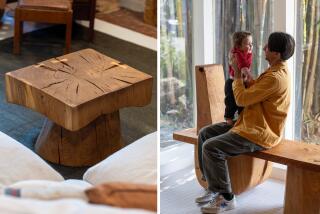Carving Out a Hobby
- Share via
Steve Grabell says he remembers the first time he ever tried to carve something: the initials “DL” in an old apricot tree behind his home in Culver City.
“They were OK, but the girl wasn’t too impressed,” said Grabell.
That was 30 years ago.
Grabell soon put down the knife, became a cop, spent 25 years on the job and retired.
Today, he has returned to carvingas a hobby, and the results are stunning.
In a studio that he converted from a den in his Calabasas home, Grabell now chisels, gouges, sands and finally paints wooden horses of the type that were popular a century ago when here were 6,000 carousels in the country instead of today’s estimated 160.
Grabell said he became fascinated with the work of a Philadelphia carver named William Dentzel after seeing pictures of his work in a book. “I don’t know how long it took Dentzel to build one of his beauties, but it takes me almost three months.”
He begins with large wooden “blanks” of basswood shaped vaguely like a horse. They cost $600 and up for an “inside row” horse to more than a $1000 for an “outside row” horse. “They call the side of the horse that faces the public the ‘romance side,’ and the other sideis rather plain.,” Grabell explained.
Today’s carousel horses are made of plastic and lack the beauty that a well-carved wooden horse has, not to mention the durability.
“I’ve heard the expression, ‘He’s the head man’ came from the guys who carved these horses.The best carver got to carve the head, “ Grabell said.
Carousel horses from the turn of the century-at least those in good shape-often are sold at art auction houses. “One recently sold for $175,000,” he said.
Copies, while not commanding such high figures, do not go cheaply. Grabell, pointing to a small gray horse that he carved last year, said, “I’ve been told that horse has a value of about $5,000.”
Grabell, whose eclectic interests have ranged from oil painting to stained glass windows to banjo playing, says the horses he carves have a more enduring nature to them: “It would be pretty neat if a hundred years from now someone would be able to enjoy these horses.”
More to Read
Sign up for The Wild
We’ll help you find the best places to hike, bike and run, as well as the perfect silent spots for meditation and yoga.
You may occasionally receive promotional content from the Los Angeles Times.






